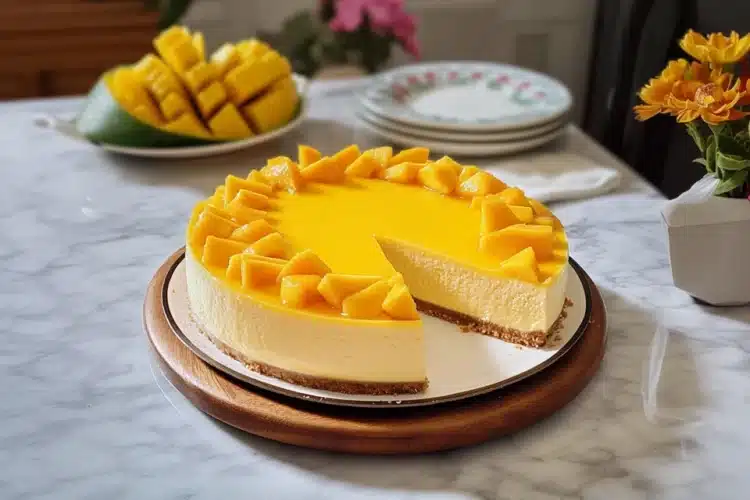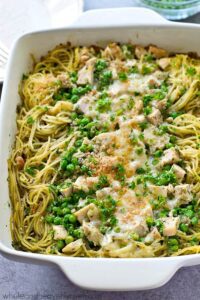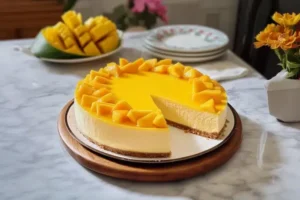Tropical Paradise Mango Cheesecake a Slice of Sunshine in Every Bite is a delicious recipe that combines amazing flavors and textures.
Tropical Paradise Mango Cheesecake: Sunshine in Dessert Form
This Tropical Paradise Mango Cheesecake represents the ultimate fusion of classic dessert technique and vibrant tropical flavors. The creamy, luxurious cheesecake base infused with fresh mango and coconut transports the senses to island paradise with every bite. This recipe demonstrates how traditional methods can be adapted to highlight seasonal fruits while maintaining the perfect texture that defines exceptional cheesecake.
The genius of this recipe lies in its balanced approach to flavor and texture. The macadamia-coconut crust provides nutty crunch that contrasts with the silken filling, while the mango topping adds fresh fruitiness that cuts through the richness. The careful temperature control through water bath baking and gradual cooling prevents cracking and ensures the velvety texture that makes cheesecake so irresistible.
Cultural Fusion in Dessert Form
This cheesecake represents a culinary meeting of traditions. The basic cheesecake technique originates from ancient Greek and Roman traditions, refined through European Jewish immigration to America. The tropical flavors draw from Southeast Asian, Polynesian, and Caribbean culinary traditions where mango and coconut are staple ingredients. The macadamia nuts add an Australian influence, creating a truly global dessert that celebrates how culinary borders have blurred in the modern era.
The specific combination of mango and cheesecake has particular significance in several cultures. In the Philippines, mango float layers mangoes with cream cheese mixture. In India, mango shrikhand combines strained yogurt with mango pulp. Brazilian sobremesa often features creamy desserts with tropical fruits. This recipe honors所有这些传统 while creating something uniquely its own.
The Science of Perfect Cheesecake
Cheesecake success depends on understanding the food science involved:
Emulsion Stability: Proper creaming of cheese and sugar creates a stable emulsion that incorporates air while preventing graininess. All ingredients must be at room temperature for even mixing.

Protein Coagulation: Eggs provide structure through protein coagulation. Overmixing incorporates too much air, causing uneven texture and potential cracking.
Water Bath Function: The water bath provides gentle, even heat that prevents overcooking the edges before the center sets. The steam also prevents surface cracking.
Gradual Cooling: Slow cooling in the turned-off oven allows gradual protein stabilization, preventing the sudden contraction that causes cracks.
Starch Function: The small amount of flour acts as a stabilizer, helping to bind excess moisture and prevent separation during baking.
Mango Varieties and Selection
Choosing the right mango significantly impacts flavor:
Alphonso: The “king of mangoes” from India, with rich, sweet flavor and minimal fiber. Ideal for purees but often expensive and seasonal.
Ataulfo/Honey: Buttery texture with sweet, rich flavor and small pit. Excellent for both puree and garnishes.
Kent: Large, green-red mango with sweet, mildly acidic flavor. Good all-purpose choice with minimal fiber.
Keitt: Green when ripe with tangy-sweet flavor and firm texture. Holds shape well for garnishes.
Tommy Atkins: Most common supermarket variety. Moderately sweet with slightly fibrous texture. Adequate when ripe.
Select mangoes that yield slightly to gentle pressure and have fruity aroma at the stem end. Avoid fruits with wrinkled skin or dark spots.
Technical Execution Tips
Master these techniques for flawless results:
Proper Creaming: Beat cream cheese alone first to eliminate lumps before adding sugar. Scrape bowl thoroughly to ensure even mixing.
Room Temperature Ingredients: Cold ingredients don’t incorporate evenly, leading to lumps or overmixing. Plan ahead for proper tempering.
Water Bath Security: Double-wrap springform pan with heavy-duty foil to prevent water leakage. Place in water bath after oven is preheated.
Doneness Test: The edges should be puffed and set while the center jiggles like Jell-O when gently shaken. Internal temperature should reach 150°F.
Cooling Protocol: After gradual oven cooling, run a knife around the edge to release tension before complete cooling. This prevents cracking from contraction.
Flavor Development Secrets
Enhance the tropical flavor profile with these techniques:
Mango Concentration: Reduce mango puree by simmering to intensify flavor without adding moisture.
Toasted Coconut: Toast coconut until deeply golden for nutty complexity that enhances both crust and garnish.
Citrus Zest: Add lime or lemon zest to filling for bright notes that cut through richness.
Spice Infusion: Steep a pinch of cardamom or star anise in the cream for subtle spice complexity.
Alcohol Enhancement: Add 1 tbsp rum or malibu coconut rum to filling for depth and authentic tropical flavor.
Modern Variations
Adapt this versatile recipe to various preferences:
Vegan Version: Use cashew-based vegan cream cheese, coconut cream, and agar agar instead of eggs and dairy.
No-Bake Option: Substitute whipped cream and gelatin for baked filling, using the same crust and topping.
Individual Portions: Bake in mason jars or ramekins for single servings with reduced baking time.
Flavor Combinations: Layer with passionfruit curd or swirl with guava puree for multi-fruit variations.
Layered Dessert: Create parfaits with crumbled crust, cheesecake mousse, and fresh mango layers.
Wine and Beverage Pairing
The tropical flavors pair beautifully with several dessert wine options:
Late Harvest Riesling: The honeyed apricot notes complement the mango while acidity balances richness.
Moscato d’Asti: Light effervescence and peach notes refresh the palate between bites.
Ice Wine: Canadian ice wine offers intense sweetness that stands up to the cheesecake’s richness.
Cocktail Pairing: Piña colada or mango mojito mocktails/cocktails enhance the tropical theme.
Tea Option: Jasmine pearl tea or coconut oolong provides aromatic counterpoint without sweetness.
Presentation Techniques
Elevate your cheesecake presentation with these professional techniques:
Mango Roses: Create rose shapes from thinly sliced mango for elegant garnishes.
Coconut Tuiles: Make delicate coconut crisps for height and textural contrast.
Puree Drizzle: Use a squeeze bottle to create artistic mango puree designs on plates.
Edible Flowers: Garnish with orchids or hibiscus flowers for dramatic tropical presentation.
Layered Slices: Serve slices on pools of mango coulis with toasted coconut and mint sprigs.
Nutritional Considerations
While indulgent, this dessert can be modified for various dietary needs:
Reduced Sugar: Decrease sugar by 25% and add ripe banana puree for natural sweetness.
Gluten-Free: Use gluten-free graham crackers or almond flour crust.
Lighter Version: Substitute Greek yogurt for some cream cheese and use egg whites for half the eggs.
Diabetic-Friendly: Use sugar alternatives specifically formulated for baking and reduce crust quantity.
Nut-Free: Omit macadamia nuts and increase coconut or use sunflower seeds for crunch.
Cultural Significance of Mango
Mango holds cultural importance across tropical regions:
South Asia: The mango is national fruit of India, Pakistan, and Philippines, featuring prominently in mythology and literature.
Southeast Asia: Mango sticky rice is ceremonial food in Thailand, while Philippines celebrates mango festivals.
Latin America: Mango features in salsas, desserts, and beverages throughout the region.
Global Adoption: Mango has become the most consumed fruit worldwide, representing tropical luxury.
Conclusion
This Tropical Paradise Mango Cheesecake represents more than dessert – it’s an edible vacation that transports the senses to sun-drenched shores. The careful balance of technique and flavor creates a showstopping dessert worthy of special occasions while maintaining approachability for home bakers. Mastering this recipe provides not just a delicious final product, but techniques that apply to countless other desserts. Each creamy, tropical bite offers a moment of blissful escape and the deep satisfaction of culinary craftsmanship.

Tropical Paradise Mango Cheesecake
Ingredients
Method
- Preheat oven to 325°F and wrap a 9-inch springform pan with aluminum foil
- Toast coconut and macadamia nuts in a dry skillet until golden and fragrant
- Combine graham crumbs, toasted coconut, macadamia nuts, and sugar in a bowl
- Add melted butter and mix until evenly moistened
- Press mixture firmly into the bottom and halfway up the sides of the prepared pan
- Bake for 10 minutes, then cool while preparing filling
- Beat cream cheese and sugar until completely smooth, about 3 minutes
- Add mango puree and mix until fully incorporated
- Add eggs one at a time, mixing just until combined after each addition
- Blend in sour cream, coconut cream, flour, and extracts until smooth
- Stir in lemon juice to brighten flavors
- Pour filling into the cooled crust and smooth the top
- Place springform pan in a larger roasting pan
- Create a water bath by adding hot water to reach halfway up the sides of the springform
- Bake for 55-65 minutes until edges are set but center still jiggles slightly
- Turn off oven and leave cheesecake in oven with door slightly ajar for 1 hour
- Remove from oven and water bath, then cool completely on wire rack
- Refrigerate for at least 8 hours or preferably overnight
- Combine diced mango, water, sugar, and lime juice in a saucepan
- Simmer for 5 minutes until mango begins to break down
- Add cornstarch slurry and cook until thickened, about 2 minutes
- Cool completely before spreading over chilled cheesecake
- Garnish with toasted coconut flakes and additional mango dice if desired
- Slice with a warm knife for clean cuts and serve chilled


